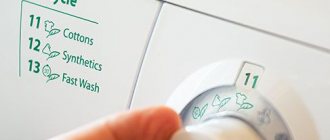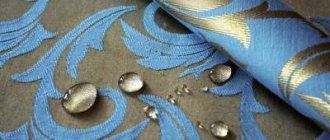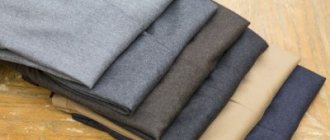When you have a pile of clothes to wash, it is important to sort the laundry not only by fabric type, but also by shade.
Do not wash different colored clothes together. In this case, a combination of related shades is allowed. Multi-colored clothes are washed with specialized products. For white, the corresponding lines are Persil, DENI, Mini Risk, LV, AOS, black – Dreft, Cotico, “Laska”, Perwoll, Clean Home, “Vorsinka”, BiMax, color – Frosch, Chirton, Perwoll, Flora, Dalli, Ariel , Klar, Help, Alpi. Loose powders and bleaches are not recommended for use on non-white laundry: they leave whitish traces. To prevent things from fading, wash in cool water or add anti-shedding wipes: Tech, Heitmann, Fix Price, Punch, Brite. To maintain brightness and prevent the appearance of faded stains, clothes are sorted by color before washing. Then, according to the paint, a suitable product is selected and the item is washed. However, what if the item is two-color? How to properly wash white bed linen with red roses or a multi-colored T-shirt? Let's take a closer look at whether it is possible to wash black and colored clothes, and what to do with contrasting fabrics.
How to wash white items with colored inserts?
When machine washing, add hydrogen peroxide and ammonia to the compartment along with the powder; it will be enough to add two tablespoons and about four tablespoons of soda. After washing, the white areas will shine clean, and the colored areas will become more vibrant. If the smell of ammonia is very unpleasant to you, then you can do without it.
Interesting materials:
What is the designation for second escape velocity? What is breakfast and dinner in hotels? How is the gap indicated? How are angles designated in geometry? How is time expressed in mathematics? How are voiced consonants designated? How are cells labeled in a spreadsheet? How are Milliamps and Microamps designated? What are normal conditions? How are Paid Parkings designated in Moscow?
What to do if things get dyed during washing
If items were not properly sorted before washing and stains and stains have formed on the fabrics, they should be quickly re-cleaned using powder and bleach.
If this method turns out to be ineffective, you should use household remedies. You can make a solution of ammonia (10 ml) and hydrogen peroxide (100 ml) by dissolving the substances in 5 liters of warm water. A metal bucket or basin is suitable as a container. Faded laundry should be soaked in the solution and heated over low heat for a quarter of an hour.
After cooling, things need to be rinsed.
Method for the machine: soak the products in a solution of 5 liters of water/10 ml of ammonia for 1 hour, squeeze out and put into the machine by activating the intensive mode.
You can use a stain remover by soaking the affected items in the solution for 30 minutes. After exposure to the stain remover, the products should be thoroughly rinsed and dried.
An alternative method is the use of ammonia and dishwashing liquid. These substances must be mixed in a 1:1 ratio and applied to the dye-damaged fabric. After 30 - 40 minutes, rinse and hang to dry.
A 6% solution of hydrogen peroxide will help clean white and light-colored clothes. The product must be lowered into a container, filled with water (5 liters) and 20 g of the composition, boiled over low heat for 30 minutes. Unnecessary paint will remain in the water.
Delicate fabrics can be removed from dyes using lemon juice or acid.
Advice! You should start cleaning the fabric immediately after it has faded.
The product should be selected in accordance with the material of the product and the resulting contaminants.
If the laundry is not very dirty, you can use powder without radical bleaching particles to clean the fibers. In order to tidy things with stubborn stains, the powder must contain special bleaching substances.
There are powders on the market that claim to be universal, but to preserve the original appearance and quality of the product, it is better to select products in accordance with the characteristics of the fabric and the washing method.
Information about caring for the item is contained on the label.
Based on it you can:
- choose the appropriate cleaning method;
- mode;
- water temperature;
- find out about the possibility of combination with other things.
Optimal amount of powder for 10, etc. l of water is indicated on the product packaging.
Note! Excess of product can lead to the formation of too much foam. If a low temperature regime is selected, the amount of powder should be reduced, because it will dissolve more slowly.
Sorting
Before washing any items, you need to inspect the tags and pay attention to the composition of the fabrics and the manufacturers’ recommendations. As a rule, they indicate at what temperature the product should be washed, whether it can be done in a machine, bleaching and other important points
Do you store laundry in the washing machine?
Oh yes! No.
It is necessary to pay attention to the composition of the fabric and the degree of contamination. Cotton, wool, and synthetics should be washed separately from each other.
The recommended temperature conditions, detergents and speed of rotation of the washing machine for different fabric compositions differ significantly.
It is advisable to wash woolen items by hand or hand wash at low temperatures using special products.
Difference for new and old clothes
New multi-colored items can be washed frequently. It is recommended to do this much less frequently with older products, because they are already quite worn out.
New textiles can be washed both by hand and in a machine. For old ones, hand washing is more suitable. It is gentle and extends the service life of the product.
New colored linen can be washed in a variety of detergents. For washing old clothes, it is recommended to choose gels. Powders wear out products faster. Gels extend the life of such items and slightly improve their color.
https://www.youtube.com/watch?v=upload
If new clothes can be washed at a temperature of 40C, then it is better to wash old and worn ones at a maximum of 30C. At this temperature, it will be able to serve for some time.
Read the article about whether you need to wash new things after purchasing them.
Features of using bleach
When working with aggressive chemicals, it is important to follow safety rules - not only sheets and washing machine parts can be damaged, but you too. Safety rules when working with chlorine-containing solutions:
- When bleaching, wear gloves and a mask. Contact of the substance with the skin causes burns, corrosion, and allergies.
- It is not advisable to use a stain remover on colored fabrics - the stain will come out, but along with it the color will lose its saturation.
- Do not use on leather, wool and silk items. Stains from them are generally very difficult to remove; compositions with chlorine will only spoil the material or cause the appearance of yellowness. Use is allowed on cotton, linen and synthetic fabrics.
- If the container with “Belizna” has been opened for a long time - six months or more, it is not worth using it, since the chemical effect of the composition is noticeably reduced.
Removing stains manually
- You need to fill the container with water. A basin with a volume of twenty liters is half filled with water;
- Add a combined detergent that softens the water. This tool differs from its automatic counterpart. You can purchase a product for manual washing at any point of sale of household chemicals;
- Soak the products in the cleaning solution. You should swirl the laundry in the water a little until it is completely wet;
- We start rinsing things first in warm water, then in cold water;
- Drying clothes. You should not immediately hang such products, as they tend to stretch. The best option for drying delicate items is to lay them out on flat surfaces.
What to do to prevent shedding?
If co-washing cannot be avoided, you can reduce the risk of light-colored fabric staining in the following ways:
Wash in cool water. Its temperature should not exceed 30 degrees.- Disable spin.
- Always turn things inside out before washing.
- Pre-soak colored fabric in a vinegar solution. To prepare it, take 1 tbsp for every liter of water. l. vinegar 9%. The laundry holding time is 1 hour.
- Use powders or gels labeled Color for washing. Such products contain components that help preserve paint in the fabric fibers.
To prevent things from fading during washing, you can use color-catching napkins . If the car is half loaded, then one piece is enough. It is placed on the bottom of the drum. When the load is full, you will need 2 napkins.
They are produced under the following brands:
- Topperr Chameleon (348 rubles),
- Heitmann (250 rubles),
- Paterra (280 rubles), etc.
They are sold in departments with household chemicals and in online markets. Their reuse is unacceptable; after completing the washing cycle, the napkins are thrown away .
Do I need to sort different clothes before washing them in a washing machine, what could be the consequences?
Often, dirty laundry is simply collected in the general wash, loaded into the machine and, having selected a mode, the process is started. At best, you might get lucky and nothing bad will happen.
But, in the end, such actions will lead to negative consequences, for example:
If you do not take into account the material from which the item is made and choose the wrong mode on the washing machine, then it may shrink.- Mistakes in choosing detergents for washing a particular type of clothing can ruin its appearance. For example, colored ones may lose their brightness, and white ones may fade or acquire a grayish tint.
- Washing white clothes together with colored ones, which tend to fade, can radically change the color of a light-colored item. The water will be colored and give a different shade to the white item. For example, if you wash it with red clothes, you may end up with a pink item.
- It is better not to combine items when washing that do not correspond to their intended purpose. For example, bed linen with sneakers and so on.
Manually
Hand washing shirts allows you to have complete control over the washing process. But this method is characterized by high labor costs.
Processing shirts by hand is indispensable in cases where you need to remove stains , or when it is necessary to process particularly delicate items.
At the same time, the choice of detergent, water temperature and spin capability are no less important than with automatic washing.
More details about the question can be found here.
How can you tell if a product is fading if there is no label?
Manufacturer's labels on the inside of clothing can be uncomfortable when in contact with the skin, so some people remove them.
If the item does not have such a label, you can determine whether it is shedding in several ways:
Some clothing manufacturers, especially branded ones, can sew a small piece of fabric on the inside of the item.
If one is present, it must be cut off, treated with ammonia, it will be enough to simply moisten it, and wait from ten to twenty minutes.
After this, rinse and dry. If after performing this procedure the flap retains its original color, then the item does not fade.
Which areas of the shirt get dirty the most?
When sewing, various fabrics are used, the most popular are cotton items. This material is especially suitable for lovers of light natural fabrics. Flax is a little rougher.
Shirts made of cotton and viscose are easy to wash, and ironing them is a pleasure. In addition, they keep their shape longer, so washing does not greatly affect the quality. Silk and satin products attract buyers with lightness and elegance. But all shirts have problem areas: collar, cuffs, armpit area. Due to street dust and car exhaust gases, the collars become dirty. Due to the strong secretion of sweat, marks are formed in the armpit area. These areas are difficult to wash. Friction not only leads to abrasions and stains, but also makes it impossible to remove stains. Therefore, washing shirts requires a special approach.
Sort by color
There are certain guidelines on how to sort items by color, but the washing process will become much more difficult if you adhere to them unquestioningly. To simplify, you can use combinations with shades. Let's take a closer look at the general rules and possible combinations of things by color.
Which ones are allowed to be processed simultaneously?
You can wash items of the following colors and shades together:
Due to the peculiarities of the choice of powder and washing temperature, dark clothes should be washed separately from everyone else, but there are exceptions to the rule.
This category is diluted with clothing in dark colors: marsh, blue, brown, khaki, purple and similar shades.
Wash them using detergents for colored clothes. You can add light items with large-scale bright, colored designs or patterns. There is no need to separate sorting by color shades, but it is important to know that it is not recommended to add clothes that may fade to this category. You can take a risk and turn such a thing inside out. This will greatly increase the chance of not ruining other items, but it is best to wash it separately.
Recommendations
Guided by all the above rules, you can achieve the desired results in washing any fabrics.
It is important to remember and strictly follow
- Choose the right detergents and washing powders for the types of fabrics.
- Approaches the choice of washing mode on a machine with the full degree of responsibility.
- Strictly follow all recommendations indicated on the product label.
- Properly rinse and dry clothes after a wash cycle.
Successful washing directly depends on your knowledge.
When washing different types of laundry, follow these recommendations:
- When washing white items, you need to monitor the temperature of the cycle. The recommended temperature is 30 degrees C. Do not wash white items with colored items, otherwise the white items may be damaged. Recommended washing powders - with a bleaching effect. It is this category of cleaning products that will give white things a natural color. It is recommended to dry white items in the sun, as they make the clothes whiter.
- Washing black clothes involves using a properly selected cycle program. It is strictly forbidden to load other items of other colors with the color black. Black is best washed from the inside out. In the laundry detergent market, the most popular detergents are for black clothes. Choose appropriate products. For white things - gel capsules for white, for black things - washing powder or gel capsule for black.
- Colored items are very sensitive to changes in color. Therefore, you should be careful when washing colored laundry. Choose the right washing powder for colored items and set up a cycle program for your washing machine. An important factor is the use of bleach. When doing color washes, using this type of detergent is strictly prohibited. It is better to resort to conditioner and gel capsules. You can wash different colors in one cycle, but you should avoid black and white shades on clothes. We recommend the washing mode for colored laundry - cotton, wool, delicate wash, quick wash mode.
Let's consider the main designations of the characteristics of labels on clothes and underwear:
| Symbol | Designation and brief description |
| Hand and automatic washing in a washing machine is allowed. A two-digit number may be displayed inside this designation; this indicates the temperature of the water during washing. | |
| This sign indicates the possibility of using additional modes (spin, rinse) | |
| The symbol indicates that the item of clothing can be ironed | |
| The symbol on the clothing indicates the possibility of professional dry cleaning and chemical treatment. | |
| The sign strictly prohibits washing. In this case, the item must be dry cleaned. |
Thus, to summarize the above, the effectiveness of washing directly depends on theoretical and practical knowledge
It is important to understand the basic concepts of washing, the principles of operation of a washing machine and correctly apply them in practice. The main thing is to choose the right detergent, carefully sort clothes and take the choice of operating mode of the washing machine seriously.
In the event of a breakdown or improper operation of the washing machine, you must contact a specialist or service center for diagnostics and professional replacement of spare parts and components. It is strongly recommended not to resort to repairing equipment yourself; entrust the work to a professional. There are many products used to prevent the operation of washing machines; they must be used directly at least once every 6 months. They are easy to use, just pour the powder into the designated area and run a minimal wash cycle without clothes. A special powder will remove all scale from the heating elements and clean the drum.
Drying rules
To prevent white and colored items from being damaged during the drying process, you must adhere to the following recommendations:











